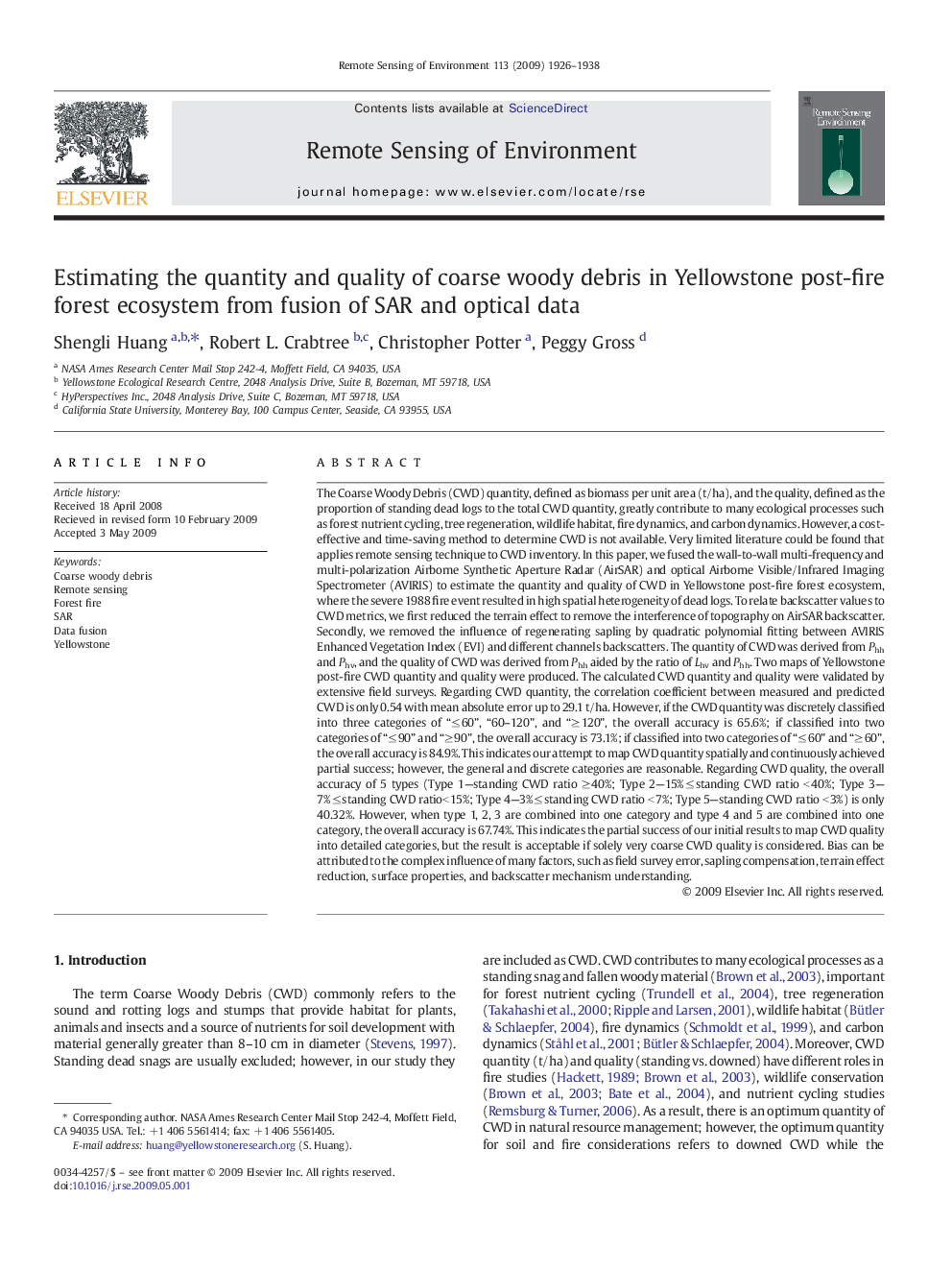| کد مقاله | کد نشریه | سال انتشار | مقاله انگلیسی | نسخه تمام متن |
|---|---|---|---|---|
| 4460158 | 1621312 | 2009 | 13 صفحه PDF | دانلود رایگان |

The Coarse Woody Debris (CWD) quantity, defined as biomass per unit area (t/ha), and the quality, defined as the proportion of standing dead logs to the total CWD quantity, greatly contribute to many ecological processes such as forest nutrient cycling, tree regeneration, wildlife habitat, fire dynamics, and carbon dynamics. However, a cost-effective and time-saving method to determine CWD is not available. Very limited literature could be found that applies remote sensing technique to CWD inventory. In this paper, we fused the wall-to-wall multi-frequency and multi-polarization Airborne Synthetic Aperture Radar (AirSAR) and optical Airborne Visible/Infrared Imaging Spectrometer (AVIRIS) to estimate the quantity and quality of CWD in Yellowstone post-fire forest ecosystem, where the severe 1988 fire event resulted in high spatial heterogeneity of dead logs. To relate backscatter values to CWD metrics, we first reduced the terrain effect to remove the interference of topography on AirSAR backscatter. Secondly, we removed the influence of regenerating sapling by quadratic polynomial fitting between AVIRIS Enhanced Vegetation Index (EVI) and different channels backscatters. The quantity of CWD was derived from Phh and Phv, and the quality of CWD was derived from Phh aided by the ratio of Lhv and Phh. Two maps of Yellowstone post-fire CWD quantity and quality were produced. The calculated CWD quantity and quality were validated by extensive field surveys. Regarding CWD quantity, the correlation coefficient between measured and predicted CWD is only 0.54 with mean absolute error up to 29.1 t/ha. However, if the CWD quantity was discretely classified into three categories of “≤ 60”, “60–120”, and “≥ 120”, the overall accuracy is 65.6%; if classified into two categories of “≤ 90” and “≥ 90”, the overall accuracy is 73.1%; if classified into two categories of “≤ 60” and “≥ 60”, the overall accuracy is 84.9%. This indicates our attempt to map CWD quantity spatially and continuously achieved partial success; however, the general and discrete categories are reasonable. Regarding CWD quality, the overall accuracy of 5 types (Type 1—standing CWD ratio ≥ 40%; Type 2—15% ≤ standing CWD ratio < 40%; Type 3—7% ≤ standing CWD ratio< 15%; Type 4—3% ≤ standing CWD ratio < 7%; Type 5—standing CWD ratio < 3%) is only 40.32%. However, when type 1, 2, 3 are combined into one category and type 4 and 5 are combined into one category, the overall accuracy is 67.74%. This indicates the partial success of our initial results to map CWD quality into detailed categories, but the result is acceptable if solely very coarse CWD quality is considered. Bias can be attributed to the complex influence of many factors, such as field survey error, sapling compensation, terrain effect reduction, surface properties, and backscatter mechanism understanding.
Journal: Remote Sensing of Environment - Volume 113, Issue 9, September 2009, Pages 1926–1938